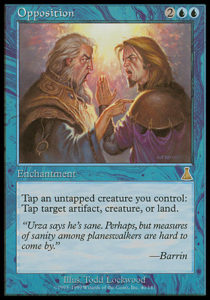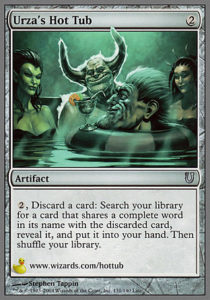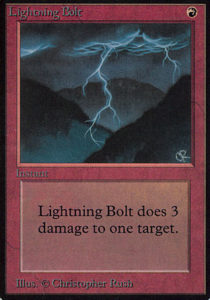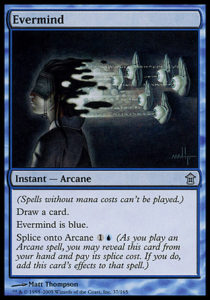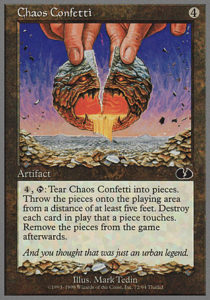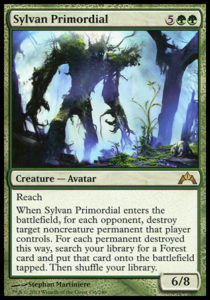When last we met, I discussed the history of my cube. Now, let us visit the present and examine revising and testing it. I recently had the privilege of drafting my cube with seven friends (including the Great Ponderer, Li). One draft is too small a sample size to come up with sweeping conclusions, but there are still lessons to learn.
My goals for my cube are for it to be fun, interactive, and have flexible archetypes. I know that different people can have different definitions of terms, so rather than debate semantics, I’ll define my terms.
What is fun is likely the most contentious and nuanced term I’ll use, so here goes. A fun match of Magic is one in which two things occur:
1. Both players enjoy playing (they have some amount of enjoyment).
2. Both players enjoy playing more than they do not enjoy playing (they have a net positive amount of enjoyment).
Magic is not fun if only one player is enjoying him or herself—this is why modern Magic has weaker counterspells and land destruction, as well as why Stasis hasn’t been reprinted since 1997. These effects are valuable and worth including, but if there is too high a density, they transform a two-person game into solitaire. Accordingly, I limit the amount of countermagic and land destruction in my cube, as well as “griefer” cards.
Ensuring “fun” is no exact science. I can’t expect players to have the same amount of fun (winning tends to be more enjoyable than losing), nor can I stop the frustration of mana flood/screw (variance is a core component of Magic). I can’t guarantee that every game or matchup will be fun (sometimes my durdle deck is just too slow to interact with aggro), and I can’t prevent players from accidentally drafting a train wreck of a deck.
I can, however, craft the cube to help each player have a net positive experience over the course of a draft. I do this by enabling interaction and flexible archetypes.
An interactive game of Magic is one in which each player can interact with his or her opponent’s strategy. If my opponent’s has powerful creatures, I can Doom Blade them; if I’m using my graveyard as a resource, then my opponent can hinder my plans with Relic of Progenitus.
Each game of Magic will not always be interactive—when I run out of Doom Blade–type effects (and creatures), my opponent will use her creatures to kill me and win. Sometimes a match will only be indirectly interactive; if my opponent neglected to draft graveyard hate, then the only way that she can prevent me from winning by reanimating powerful creatures is by killing me first (which should be feasible). All other things being equal, no match should be completely uninteractive;* no deck should have a strategy that can’t be disrupted.
(*Sometimes I draft a train wreck. Things go horribly awry and produce decks that cannot win or are too slow to win.)
While I can’t guarantee that every game or match will be interactive, I can ensure that my cube is interactive. If there are strong themes, like graveyard-based decks, then there should be many ways to answer them. These answers should be plentiful (so that every player can get some) and (mostly) maindeckable. Scavenging Ooze (which will likely be reprinted this summer in Magic 2014) and Thraben Heretic are reasonable cards that incidentally hose graveyard strategies. Tormod’s Crypt and Purify the Grave are more powerful graveyard hosers, but are otherwise useless cards. If all answers are as narrow as Tormod’s Crypt, then winning games becomes a matter of drafting sideboards, not maindecks. I’d rather players be able to interact in game one and not need to reconstruct their decks for every second game in order to interact.
Evermind is what Magic R&D calls a “parasitic” card. If you put it in your deck, you want to put other cards (in this case, Arcane cards) in your deck to get value from it. Poison is another parasitic mechanic; if your Scars of Mirrodin draft deck has a combination of infect creatures and non-infect creatures, then your opponent effectively starts the game at 30 life (since infect creatures don’t do regular damage and non-infect creatures don’t do poison damage). The Magic Online cube has an extremely parasitic deck—storm. I dislike this choice because cards like Lion’s Eye Diamond and Brain Freeze only go into a dedicated storm deck and are useless to every other draft deck. If a cube has too many parasitic cards, then drafting becomes a matter of recognizing what premade theme is open, rather than drafting your own deck. Parasitic cards have the advantage of creating archetypes (or themes) that reward players for recognizing card interactions.
Modular cards are the opposite of parasitic cards—having one such card in your deck doesn’t incentivize you to put similar cards in your deck. Cycling, kicker, and split cards are modular. Modular cards are very flexible because they go into a whole host of decks. The danger of filling a cube with too many modular cards is that decks become homogenous; you draft the best card out of every pack (since, naturally, every card goes into every deck) and get enough mana fixing to play everything. An overly modular cube is full of five-color control decks.
I try to find my balance with this by having flexible archetypes. There are broad archetypes, like aggro, control, and ramp. There are enough modular cards to support a host of decks as well as parasitic interactions that reward the keen-eyed drafter. There are aggro cards that don’t go in decks with control cards; there are parasitic cards that work well by themselves but get better with friends. Aggro as an archetype is available to all colors, as is control (blue/green aggro and red/white control are draftable decks, if not the most common choices).
So, there you have it—the basics of my cube philosophy. Broad archetypes, some parasitic card combinations, ways to interact with every archetype, and an emphasis on fun. Now, let’s see how well everything went. It was, in a word, a…
(Nah, I’m kidding. It was pretty fun. But the card is integral to the experience.)
Lesson #4: Some cards are net negative fun
I mentioned land destruction as a dangerous—but important—effect. Land destruction helps aggro decks slow down control or attack their manabases. Players can employ the ultimate land destruction, Armageddon effects, to turn a quick start into an assured victory. These are powerful but can lead to miserable play experiences. I included such cards: Catastrophe (intended to be wrath that might be an Armageddon, but would generally be too slow for an aggro deck to employ) and Desolation Angel (a potential control finisher).
This past Saturday, Catastrophe saw a lot of play in Sean’s ramp deck and demonstrated how unfun a turn four Ravages of War is. The bigger surprise was how powerful and uninteractive Sean’s deck was.
Lesson #5: Some archetypes are hard to interact with
As you may recall, tokens and control were powerful themes that I have since reined in. Tokens was problematic because its anthems were difficult to destroy and it was resilient against wraths (the best answer available). Control was problematic because its plan of “produce massive card advantage” was unstoppable and it couldn’t be killed fast enough for non-control decks to have a chance.
I mentioned last week that some control decks were ramp/control. As it turned out, while aggro and midrange are much more powerful, they weren’t able to stop the ramp decks. The table supported multiple ramp players, of which Sean’s deck was likely most powerful (thanks to him having Catastrophe and almost all of green’s ramp targets).
It’s too soon to tell whether ramp is a problem that needs be dealt with or if Sean’s deck was merely very powerful (again, he had ALL of green’s ramp targets). Additionally, while all of the most powerful ramp cards were in the draft, many of the most powerful control cards were not drafted (my cube contains 540 cards, so in an eight-person draft, 180 are left aside). However, I recognize that ramp is difficult to interact with—if you don’t have counterspells, that is—and that’s something to keep in mind as I maintain my cube.
So I put it to you, my readers: What are your favorite ways to interact with ramp decks? There’s everything from Tunnel Ignus and Avalanche Riders to Ankh of Mishra and Hokori, Dust Drinker (who also works quite well in ramp, just as Catastrophe does). What are good, maindeckable ways for white, black, and blue to interact with ramp?
As always, thank you for reading. Here’s looking forward to many, many cube drafts.
—Zach B.

